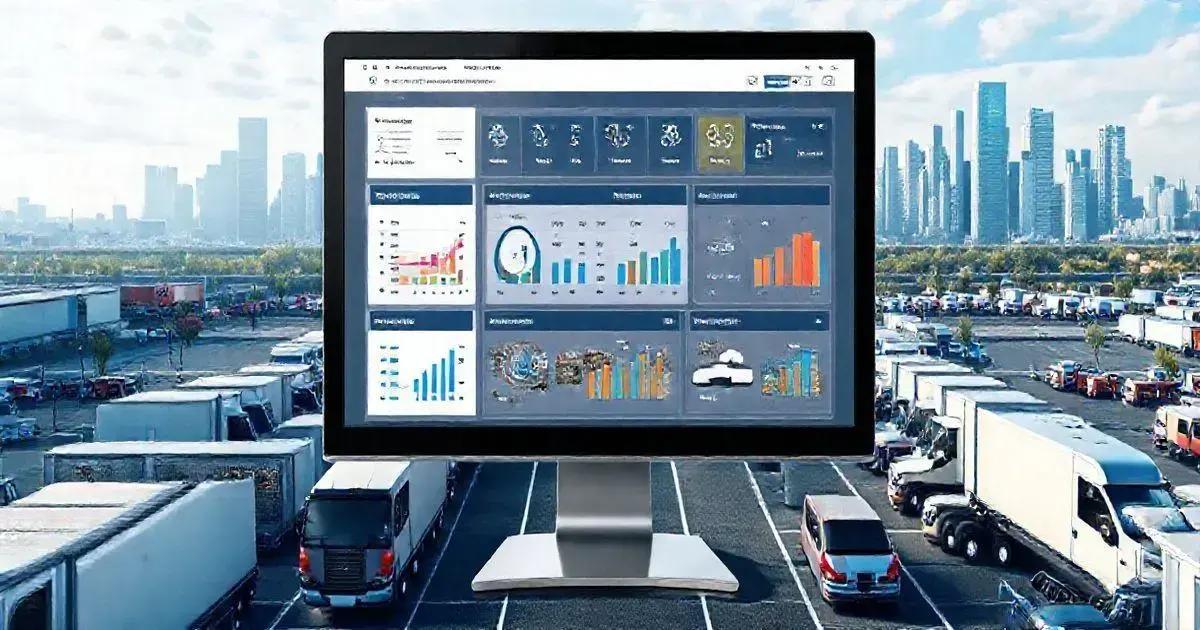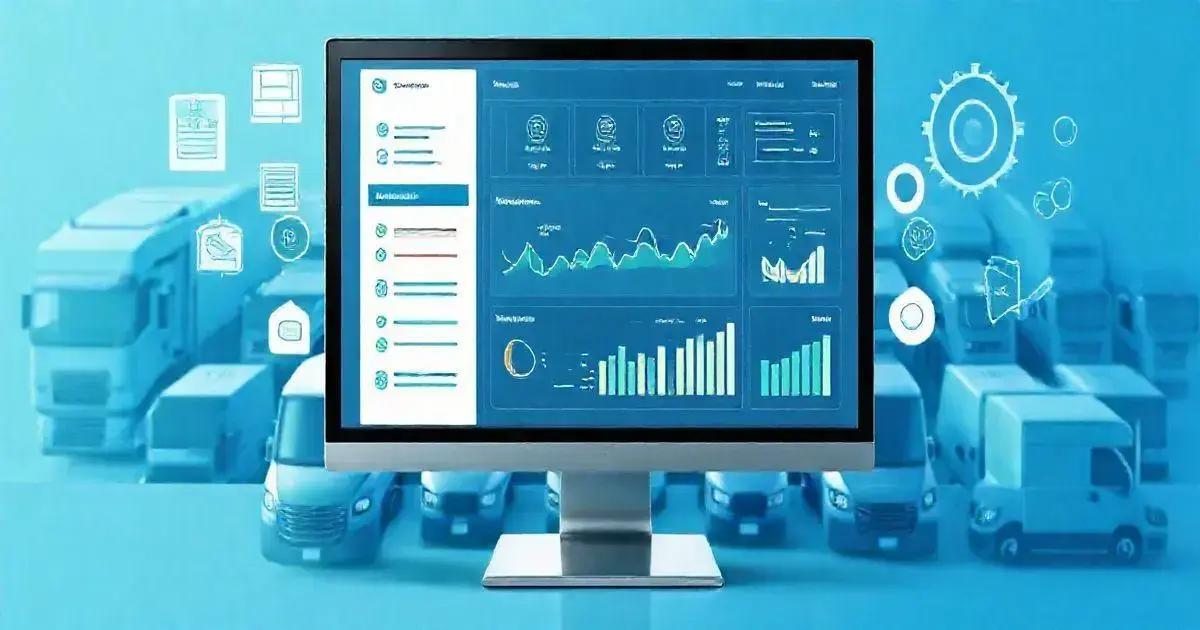Top 7 Features of Fleet Control Worksheet 7.0 You Need Leave a comment
The Fleet Control Worksheet 7.0 is an essential tool for fleet managers, offering features like initial dashboards for key metrics, centralized driver and vehicle registrations, document management for compliance, travel control functions for efficient operations, tire lifecycle management, maintenance tracking with alerts, and yearly performance analysis, all aimed at optimizing fleet efficiency and reducing costs.
The Fleet Control Worksheet 7.0 is a game changer for anyone managing a fleet of vehicles. With its robust set of features, it streamlines all your operational needs, from maintenance tracking to fuel management. Let’s dive into what makes this worksheet indispensable for fleet management!
Initial Dashboards Overview
The Initial Dashboards in Fleet Control Worksheet 7.0 provide a comprehensive overview of your fleet’s performance at a glance. Here’s a breakdown of the key components:
- KM by Driver: This feature allows you to track the distance each driver has covered, helping you identify high performers as well as those who may need additional training or resources.
- KM per Vehicle: Monitor the mileage of each vehicle in your fleet. This data is crucial for maintenance scheduling and to understand vehicle usage patterns.
- KM per Liter: This metric provides insight into fuel efficiency, enabling you to assess how well each vehicle is performing concerning fuel consumption.
- KM per Trip: Track the distance covered on individual trips, which can help in planning and optimizing future routes.
- Average Consumption per Vehicle: Calculate the average fuel consumption for each vehicle over a specified period, giving you a clearer picture of overall efficiency.
- Average Consumption per Driver: This metric helps to compare fuel usage among drivers, encouraging accountability and promoting eco-friendly driving practices.
- Total General Maintenance: Keep track of all maintenance activities across your fleet. This feature helps in planning maintenance schedules and managing costs effectively.
- Preventive and Corrective Maintenance Costs: This overview details the costs associated with both preventive and corrective maintenance, allowing you to manage your budget more effectively.
- Total Cost of Mechanical and Electrical Maintenance: With this feature, you can analyze the expense of maintaining mechanical and electrical systems within your fleet, which is essential for budgeting.
- Total Maintenance Cost per Tire: This metric breaks down tire-related maintenance costs, offering insights that can help in inventory management and procurement strategies.
- Total Lubricant Cost: Track lubricant expenses, which can sometimes be overlooked but are vital for keeping your vehicles in optimal condition.
- Vehicles in Transit: Monitor which vehicles are currently on the road, helping you manage resources and respond quickly to any issues that arise.
- Tires in Transit: This feature allows you to keep track of tires that are being used, ensuring that you have the right inventory on hand when needed.
- Delayed Vehicle Documents: Stay on top of all necessary documentation to ensure compliance and reduce the risk of fines or penalties.
- Delayed Driver Documents: Similar to vehicle documents, this feature helps in keeping track of driver certifications and licenses.
- Delayed Preventive Maintenance: Monitor any overdue preventive maintenance tasks, ensuring that your fleet is always operating at peak efficiency.
- Total Cost Versus Shipping: Compare your total operational costs against shipping performance, making it easier to identify areas for improvement.
- Fuel, Maintenance, and Other Costs: This comprehensive overview allows fleet managers to view all expenses associated with the fleet, providing a more complete understanding of overall operational costs.
By utilizing these dashboards, fleet managers can quickly make informed decisions that enhance efficiency and reduce costs. The Fleet Control Worksheet 7.0 transforms how you manage your fleet, making data accessible and actionable.

Driver and Vehicle Registrations
The Driver and Vehicle Registrations section of the Fleet Control Worksheet 7.0 is designed to simplify and centralize the management of your fleet’s personnel and assets. Here’s what you can expect from this comprehensive feature:
- Driver Registration: This feature allows you to input and maintain up-to-date information for all your drivers. Key details to capture include:
- Name
- Contact Information
- License Number and Expiry Date
- Emergency Contact Information
- Training and Certification Records
By keeping this information organized, you can easily track driver qualifications and compliance with regulations.
- Vehicle Type Registration: Record essential details about each vehicle in your fleet. Key information includes:
- Vehicle Make and Model
- VIN (Vehicle Identification Number)
- License Plate Number
- Purchase Date and Price
- Current Mileage
- Insurance Information
This data helps you manage your fleet’s inventory and ensures you’re aware of each vehicle’s status at all times.
- Mechanical and Electrical Services Registry: Keep track of all the mechanical and electrical services performed on each vehicle. This can include:
- Service Dates
- Type of Service Performed
- Service Provider Information
- Costs Associated with Each Service
Such records are vital for maintenance planning and budget management.
- Tree Service Registration: This feature allows you to log details about specific services related to vehicle care, such as tree service registrations, which might be pertinent for vehicles tailored to specific operational needs.
- Lubricant Services Register: Track lubricant purchases and servicing to ensure that all vehicles receive the necessary maintenance to operate smoothly. This may include:
- Type of Lubricants Used
- Service Dates
- Cost of Lubricants
- Register of Workshops and Suppliers: Maintain a list of reliable workshops and suppliers for your fleet’s needs. Information to capture includes:
- Name and Contact Information
- Services Offered
- Location
- Ratings and Reviews
This helps you quickly identify where to turn for repairs or supplies, ensuring minimal downtime for your fleet.
- Expenditure Type Register: Document various types of expenditures related to fleet operations, making it easier to track where money is going and how it can be managed better.
- Refueling Station Registration: Keep a record of refueling stations used by the fleet. Key information includes:
- Location
- Type of Fuel Available
- Contact Information
This helps in planning refueling routes and ensuring that drivers always have access to the necessary fuel types.
- Fuel Type Register: Maintain a log of the types of fuel used by each vehicle, making it easier to manage costs and optimize fuel efficiency.
By effectively managing driver and vehicle registrations, the Fleet Control Worksheet 7.0 helps streamline operations, enhances compliance, and ultimately contributes to a more efficient fleet management experience.
Document Management Features
The Document Management Features in the Fleet Control Worksheet 7.0 are essential for keeping track of all critical documents related to both drivers and vehicles. Effective document management not only ensures compliance but also enhances operational efficiency. Here’s a closer look at what this feature includes:
- Driver Document Control: This section allows you to maintain a comprehensive file for each driver, including:
- License Copies: Ensure that all driver licenses are up to date and stored securely.
- Certification Documents: Keep track of any specific certifications, such as hazardous materials handling or defensive driving courses.
- Medical Examination Records: Maintain records of medical exams that may be required by law for commercial drivers.
- Background Check Documentation: Store documentation related to background checks for easy reference.
This organized approach helps quickly verify compliance and manage driver qualifications.
- Vehicle Document Control: Similar to driver documentation, managing vehicle documents is crucial. This includes:
- Registration Papers: Store vehicle registration documents to ensure they are always at hand.
- Insurance Policies: Keep copies of insurance documents for each vehicle to ensure compliance with regulations.
- Inspection Certificates: Record details of periodic inspections, including dates and results.
- Service History: Maintain a history of all services performed on the vehicle, which can help in assessing the vehicle’s condition.
By keeping these documents well-organized, you can ensure that your vehicles meet all regulatory requirements and are safe to operate.
- Document Expiration Monitoring: The Fleet Control Worksheet 7.0 includes alerts and reminders for document expirations. This feature helps you stay on top of:
- Driver License Expiration
- Vehicle Registration Renewal Dates
- Insurance Policy Expiration
By actively monitoring these dates, you can avoid potential fines or interruptions in service.
- Document Storage and Retrieval: Easily store and retrieve all documents related to drivers and vehicles in a centralized location within the worksheet. The intuitive layout allows for quick access to files when needed.
- Document Version Control: Keep track of different versions of important documents, ensuring that you always have the most recent documents at hand while also maintaining historical records for reference.
By implementing robust document management features, the Fleet Control Worksheet 7.0 not only enhances compliance but also promotes seamless operations across your fleet. This organized approach allows fleet managers to focus on what matters most—efficiently managing their operations and improving service quality.

Travel Control Functions
The Travel Control Functions in the Fleet Control Worksheet 7.0 are designed to provide comprehensive monitoring and management of all travel-related activities. This feature helps fleet managers ensure that travel is efficient, cost-effective, and compliant with company policies. Here’s a closer look at what these functions include:
Cargo Control Linked to Trips: This function allows you to track the cargo associated with each trip, ensuring that all shipments are accounted for. Key aspects include:
- Cargo Description: Document what is being transported for clear visibility.
- Weight and Volume: Keep track of the weight and volume of cargo, which is essential for compliance with transportation regulations.
- Destination Information: Record where each load is being delivered, helping in logistical planning.
Vehicle Control: Monitor which vehicles are assigned to specific trips. This feature helps ensure that the right vehicle is used for each job, taking into account:
- Vehicle Capacity: Match vehicles to loads based on capacity.
- Vehicle Availability: Track which vehicles are in use and which are available for new assignments.
- Vehicle Maintenance Status: Ensure vehicles are in proper condition before each trip.
Driver Control: Manage driver assignments for each trip to ensure compliance with regulations and operational efficiency. This includes:
- Driver Schedule: Keep track of which drivers are assigned to each trip.
- Working Hours: Monitor driver hours to ensure compliance with legal regulations regarding driving limits.
- Driver Performance: Evaluate driver performance based on trip data for potential training needs.
Supply Control: Monitor all supplies needed for each trip, such as fuel, oil, and emergency equipment. This includes:
- Fuel Management: Track fuel purchases and usage for each trip to manage costs effectively.
- Maintenance Supplies: Ensure that vehicles are stocked with necessary maintenance supplies before departure.
Control of All Travel Expenses: This function tracks all expenses incurred during trips, including:
- Fuel Costs: Document fuel expenses to ensure budget compliance.
- Toll and Parking Fees: Keep records of tolls and parking fees associated with trips.
- Driver Expenses: Track any expenses incurred by drivers, such as meals and accommodations, for accurate reimbursement.
By implementing these Travel Control Functions, the Fleet Control Worksheet 7.0 empowers fleet managers to optimize travel routes, reduce operational costs, and enhance overall fleet efficiency. This comprehensive approach ensures your fleet operates smoothly and effectively while keeping costs in check.
Tire Control Insights
The Tire Control Insights feature in the Fleet Control Worksheet 7.0 is essential for managing the lifecycle and performance of tires used across your fleet. Proper tire management not only enhances safety but also contributes to fuel efficiency and overall vehicle performance. Here’s a detailed overview of what this feature entails:
- Identification for Each Tire: This function allows you to assign unique identifiers to each tire, making it easy to track their usage and service history. Key details include:
- Tire Brand and Model
- Serial Number
- Date of Purchase
- Tire Change Schedule by KM: The worksheet enables you to establish a tire change schedule based on mileage, ensuring that tires are replaced before they wear out. This helps in:
- Predictive Maintenance: Anticipate tire replacements and avoid unexpected breakdowns.
- Cost Management: Plan for tire budget allocations based on projected usage.
- Signal of How Much KM is Left to Change the Tire: Monitor the remaining mileage before a tire reaches the end of its service life. This feature includes:
- Current KM on Tire
- Estimated KM Until Replacement
- Alerts for Upcoming Changes
Such monitoring ensures proactive management, minimizing the risk of tire failures on the road.
- Status per Action: Keep track of the tire’s current status and actions taken, such as:
- Allocate to Vehicle: Document which vehicle the tire is currently assigned to.
- Remove from Vehicle: Track when tires are taken off vehicles for any reason.
- Scrap: Manage the disposal of worn-out tires responsibly.
- Maintenance Actions: Log any maintenance tasks performed on the tires, such as rotations or pressure adjustments.
By utilizing the Tire Control Insights feature, fleet managers can significantly enhance tire management, leading to improved safety, reduced costs, and better overall fleet performance. This strategic approach helps in maintaining the fleet’s efficiency and longevity.

Maintenance Control Features
The Maintenance Control Features in the Fleet Control Worksheet 7.0 provide fleet managers with essential tools to ensure that all vehicles are maintained properly and efficiently. This feature is crucial for prolonging the lifespan of vehicles, enhancing safety, and minimizing downtime. Here’s a detailed look at what these features include:
- Corrective and Preventive Maintenance Type: This feature allows you to categorize maintenance tasks into two essential types:
- Corrective Maintenance: Address issues that arise unexpectedly, such as breakdowns or repairs needed due to damage.
- Preventive Maintenance: Schedule regular maintenance tasks to prevent problems before they occur, such as oil changes, tire rotations, and system checks.
- Maintenance by Vehicle: Track maintenance tasks specific to each vehicle in your fleet. Key details include:
- History of Services Performed: Document past maintenance work for each vehicle to identify patterns or recurring issues.
- Scheduled Maintenance Tasks: Maintain a schedule for upcoming maintenance based on mileage or time intervals.
- Maintenance by Mechanical and Electrical Type: This feature helps categorize maintenance activities by their nature:
- Mechanical Maintenance: Track services related to the vehicle’s physical components, such as brakes, the engine, and transmission.
- Electrical Maintenance: Monitor services related to electrical systems, including battery checks and wiring repairs.
- Maintenance Cost Tracking: Keep a detailed log of all costs associated with maintenance tasks. This includes:
- Labor Costs: Track the expenses related to maintenance labor.
- Parts and Materials: Document costs for replacement parts, fluids, and any other materials used during maintenance.
- Total Maintenance Expenditure: Monitor the total costs over time to help manage the maintenance budget effectively.
- Preventive Maintenance Schedule: Create a clear schedule for preventive maintenance tasks:
- Set Reminders: Notifications for upcoming preventive maintenance to ensure tasks are performed on time.
- Mileage Tracking: Monitor mileage to determine when preventive maintenance should occur based on vehicle usage.
- Preventive Maintenance Signal: This feature provides alerts related to preventive maintenance tasks:
- Status Monitoring: Track the completion status of scheduled preventive maintenance tasks.
- Alerts for Delayed Maintenance: Notifications to help you keep on schedule and avoid overdue tasks.
- Status by: Scheduled, Accomplished, and Delayed: This feature tracks the status of maintenance tasks:
- Scheduled: Identify tasks that are planned but not yet completed.
- Accomplished: Keep a record of completed maintenance tasks for reference.
- Delayed: Monitor tasks that are overdue to ensure they are completed as soon as possible.
By leveraging the Maintenance Control Features of the Fleet Control Worksheet 7.0, fleet managers can ensure that all vehicles are well-maintained, thus improving reliability and reducing the chance of unexpected repairs. This organized approach helps optimize fleet operations and expenditures.
Yearly Analysis and Reporting
The Yearly Analysis and Reporting feature in the Fleet Control Worksheet 7.0 is designed to provide fleet managers with a comprehensive overview of fleet performance over the year. This analysis is critical for making informed decisions that can enhance operational efficiency and cost management. Here’s a detailed look at the functionalities included in this feature:
- Total Travel: This section summarizes the total distance traveled by the fleet over the year. Key insights include:
- Aggregate KM driven by all vehicles.
- Trends in travel distance to identify peak usage times or underutilized assets.
- Cost with Preventive and Corrective Maintenance: Analyze the total expenditures related to maintenance:
- Breakdown of costs for preventive versus corrective maintenance, helping to identify areas for improved maintenance practices.
- Comparison of maintenance costs over the year to previous periods to track efficiency and budgeting.
- Fuel Consumption: Review total fuel consumption figures for the fleet to assess efficiency:
- Calculate average fuel consumption per vehicle.
- Identify patterns in fuel use, such as spikes during certain months, which may warrant investigation.
- Fuel Cost: Track the total costs associated with fuel purchases over the year, including:
- Monthly fuel expenditures to identify trends or budget overruns.
- Comparative analysis of fuel prices to optimize purchasing decisions.
- KM Run: Monitor the total kilometers run by each vehicle to assess usage:
- Identify vehicles that are over- or under-utilized, which can inform decisions about fleet composition.
- Utilize this data to plan for future vehicle purchases or retirements based on overall performance.
- Average KM per Liter: Evaluate fuel efficiency across the fleet by calculating the average kilometers traveled per liter of fuel consumed:
- Identify fuel-efficient vehicles and those that may require maintenance or replacement.
- Use this data to implement fuel-saving measures or driver training programs.
- KM per Maintenance: This metric helps in analyzing the relationship between maintenance interventions and vehicle usage:
- Track how often vehicles require maintenance based on total kilometers driven.
- Identify any trends that can lead to adjustments in the maintenance schedule.
- Total Cost: Summarize all costs associated with the fleet, including:
- Maintenance costs, fuel expenditures, and other operational costs.
- Comparison of total costs against revenue generated by the fleet to evaluate profitability.
- Full Shipping Overview: Analyze shipping performance over the year to identify strengths and weaknesses:
- Compare shipping data with costs to determine overall efficiency.
- Identify opportunities for improving delivery times or reducing costs through better route planning.
By utilizing the Yearly Analysis and Reporting feature in the Fleet Control Worksheet 7.0, fleet managers can make data-driven decisions that enhance overall fleet performance, streamline operations, and reduce costs. This analytical approach ensures your fleet remains competitive and efficient throughout the year.
Conclusion
In conclusion, the Fleet Control Worksheet 7.0 is an invaluable tool for fleet managers aiming to enhance the efficiency and performance of their operations.
With robust features such as travel control functions, tire control insights, maintenance control features, and yearly analysis and reporting, this worksheet provides a comprehensive approach to managing a fleet effectively.
By implementing the strategies outlined in this tool, you can ensure that your fleet operates at peak efficiency, minimizes costs, and maintains compliance with industry regulations.
Whether it’s tracking driver and vehicle registrations, managing maintenance schedules, or analyzing yearly performance data, the Fleet Control Worksheet 7.0 empowers you to make informed decisions that drive success.
Investing in such a comprehensive management system not only streamlines your operations but also contributes to a more sustainable and profitable fleet.
Embrace the capabilities of Fleet Control Worksheet 7.0 and take your fleet management to the next level.
FAQ – Frequently Asked Questions about Fleet Control Worksheet 7.0
What is the purpose of the Fleet Control Worksheet 7.0?
The Fleet Control Worksheet 7.0 is designed to help fleet managers track and manage all aspects of fleet operations, including vehicle maintenance, fuel consumption, driver records, and overall performance analysis.
How does the Maintenance Control feature work?
The Maintenance Control feature allows you to categorize and track both preventive and corrective maintenance tasks for each vehicle, helping to ensure that all necessary services are performed on time.
Can I track fuel consumption and costs with this worksheet?
Yes, the worksheet provides tools to monitor fuel consumption and associated costs, allowing for better budgeting and identification of fuel efficiency trends.
How do I manage driver and vehicle registrations?
You can easily input and maintain detailed records for each driver and vehicle, including licenses, insurance documents, and service history, all within the worksheet.
What kind of insights can I gain from the Yearly Analysis and Reporting feature?
This feature provides a comprehensive overview of your fleet’s performance over the year, allowing you to analyze travel distances, maintenance costs, fuel consumption, and overall operational efficiency.
Is the Fleet Control Worksheet 7.0 compatible with different versions of Excel?
Yes, the worksheet is designed to work with various versions of Excel, making it accessible to a wide range of users.

